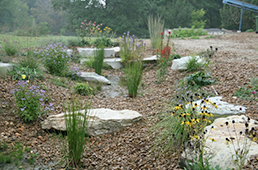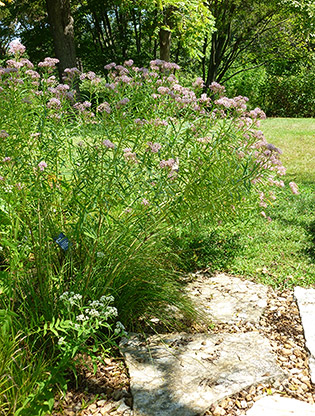 A rain garden design requires that certain features or elements be included to maximize its potential to manage rainwater effectively. Each of the areas or zones of a rain garden dictates what plants can be used based on potential moisture levels in the soil.
A rain garden design requires that certain features or elements be included to maximize its potential to manage rainwater effectively. Each of the areas or zones of a rain garden dictates what plants can be used based on potential moisture levels in the soil.
Settling Basin
This is at the lowest depth of the rain garden and is the ponding area where the majority of the water is temporarily held. The basin is approximately 6″ deep and is the last area of the rain garden to dry out. As the water flows into and fills the basin, it is slowed down. It is here that much of the water is absorbed and filtered by the soil and plants.
Transition Zone
This area surrounds the basin and is often referred to as the lower and upper slopes of the rain garden. The sloped sides of a bioswale and the bioswale itself are also considered transition zones. Soil in this zone dries out more quickly than the basin.
Berm
When installing a rain garden on a slope, a berm is constructed on the downhill side using the soil excavated from the basin to create the berm. When building the berm, the soil should be firmed and reinforced with biodegradable erosion netting and vegetation to increase its stability and prevent settling. If the rain garden is on flat ground, a berm is not necessary. Look for ways to use the excavated soil elsewhere on the property for other projects.
 Bioswale
Bioswale
A bioswale is a linear, open, vegetated channel that directs rainwater runoff from its source to a rain garden, from a rain garden to the traditional rainwater system (culvert, etc.), directs water flow through a property, or simply catches water as it flows off edges of pavement. It functions like a rain garden by slowing water flow and allowing water to be absorbed by the soil and plants. In some situations, such as narrow spaces and steep slopes, bioswales are used either instead of rain gardens or to connect many small rain gardens together. The use of erosion control fabric, or 2–3″ diameter gravel/stone is recommended in areas of potential high water flow to prevent erosion, especially during the plant establishment phase.
 Overflow Spillway
Overflow Spillway
An overflow spillway is a small indentation in the berm of a rain garden that serves as the point where excess water will flow out of the garden should it overfill during a major rain storm. This indentation can also be filled with gravel. The indentation should be made on the downhill side and is used to direct water flow towards the traditional rainwater system (culverts, etc.). An option is to construct a bioswale below the overflow spillway rather than allowing runoff to flow over the lawn.
Continue on to Organize Water Flow